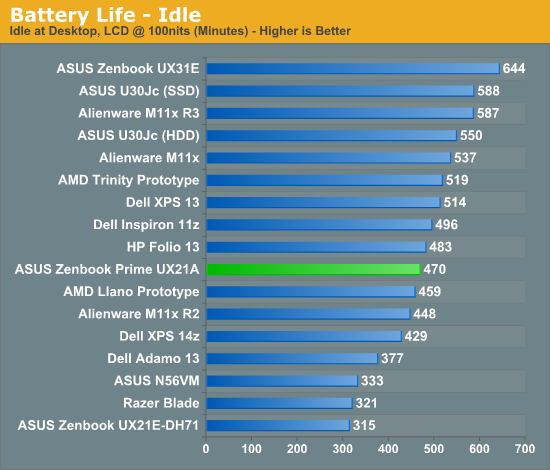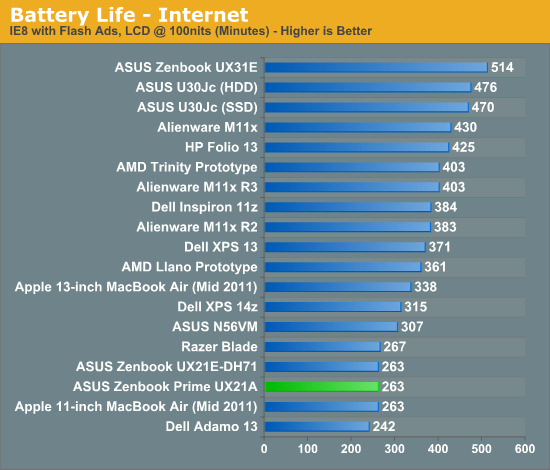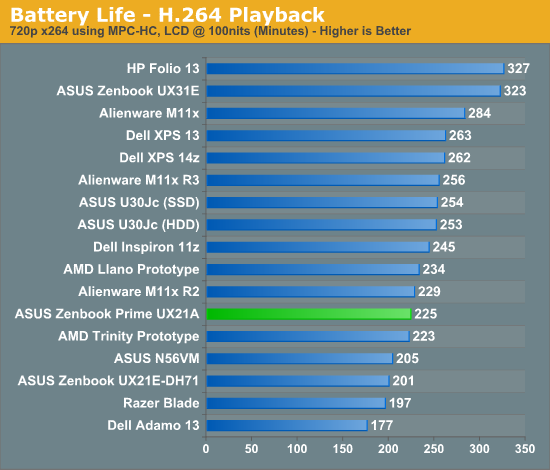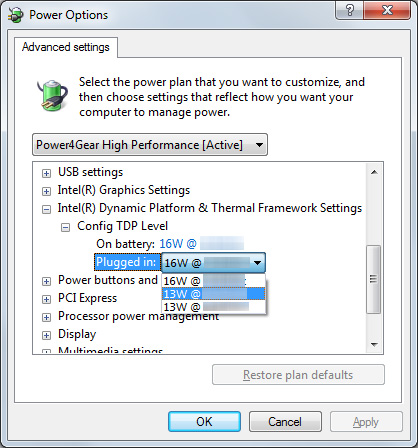ASUS Zenbook Prime (UX21A) Review: The First of the 2nd Gen Ultrabooks
by Anand Lal Shimpi on May 22, 2012 2:46 PM EST- Posted in
- Laptops
- CPUs
- Asus
- Ivy Bridge
- Zenbook
- Zenbook Prime
- Ultrabook
- Notebooks
Battery Life
Generally speaking, the 11-inch Zenbook Prime delivers about the same amount of battery life as its predecessor. For some reason we're able to hit much longer idle battery life on the Prime than the original Zenbook although I'm still trying to find out why. There's also an 11% improvement in our x264 playback test, but on average I'd expect to see similar battery life to the Sandy Bridge model - just with better performance. Note that these results also come despite the fact that ASUS is driving a much higher resolution, and presumably higher power, display than the original Zenbook.



The Zenbook Prime bucks the trend Jarred saw with the first Ivy Bridge notebook review where battery life took a small step backwards. These results bode well for future Ivy Bridge notebooks and Ultrabooks. It still remains to be seen if Intel's 22nm process will actually give us a battery life advantage in any notebook compared to its predecessor. It's possible that we are seeing some of the benefits of 22nm here already and they are simply offset by the more power hungry display. With the move to 22nm Intel should have a better hold on active power and leakage, but it's always possible that we'll have to wait until Haswell for the process to really be exploited.
Just like last time, ASUS has a couple of widgets to quickly change between power settings. The instant on widget lets you switch between suspend to RAM and suspend to disk modes. The former is expected to deliver up to 2 weeks of standby battery life, while the latter can push up to 150 days. I didn't have the time to test these claims (life is short, I draw the line at spending it testing claims of 150 day standby battery life). ASUS once again includes a counter that estimates how long your system will last in either mode based on current charge levels and power usage.
The next widget is a quick tool to let you switch between high performance and battery saver Power4Gear power profiles. You can customize these profiles via the Windows control panel, but it's nice to have a button on the desktop that lets you quickly switch between them.
Configurable TDP
One feature of Ivy Bridge that we haven't been able to test until now is configurable TDP. While most Ultrabook CPUs ship with a 17W TDP, that's mostly an arbitrary thermal/power rating. If an OEM wants to design a chassis that can only accept a 13W part it previously had to hope that Intel would make such a thing. Alternatively, the OEM could underclock/undervolt a 17W chip on their own and hope to mimic Intel's validation and deliver a 13W configuration of their own. The former requires that a significant number of OEMs demand the part, while the latter is just too risky for the larger OEMs (get too aggressive on the undervolting side and end up with a bunch of unstable systems). The solution Intel proposed with Ivy Bridge is configurable TDP. For Ultrabooks this means you can set a 17W part to 13W.

Currently the setting is hidden away in Windows 7's power management settings. Once again I've had to censor the clock speeds here due to Intel's Ultrabook embargo:
You can map the 13W settings to the battery saver profile and then, at the click of a button, have a 13W Zenbook Prime instead of a 17W model. The difference in performance isn't significant however:
| ASUS Zenbook Prime Configurable TDP Performance - Cinebench 11.5 (Multithreaded) | |||||||
| 16W - Max Freq | 13W - Mid Freq | 13W - Lowest Freq | |||||
| ASUS Zenbook Prime UX21A | 2.79 | 2.67 | 2.67 | ||||
I'm still running battery life tests to quantify the impact on power consumption, but it's conceptually a neat thing to see in action finally. I suspect configurable TDP is going to play a major role with Haswell and convertible/dockable Ultrabook-tablet hybrids.
Thermals and Noise
As with most high performance notebooks that are this thin, cooling is difficult. Under load the fans in the Zenbook Prime are definitely audible, but in general ASUS does a better job cooling everything inside the Zenbook Prime than Apple does in the MacBook Air. I suspect much of this boils down to how aggressive Apple is about keeping fan speed/noise down compared to ASUS' desire to maintain a certain temperature level inside the chassis.










192 Comments
View All Comments
sonelone - Tuesday, May 22, 2012 - link
I really wish more manufacturers would do something similar to Sony's Vaio Z series, having a slim ultrabook but also giving it the capability of a dedicated GPU when plugged in. The UX31 would be the perfect laptop for me if it had that.Impulses - Tuesday, May 22, 2012 - link
Are you gonna be reviewing the larger model as well?JarredWalton - Wednesday, May 23, 2012 - link
Yes, both of them is the plan. Stay tuned....nortexoid - Tuesday, May 22, 2012 - link
They should seriously consider a Trinity option. Nobody will be doing heavy CPU lifting on an 11 inch ultra book so Trinity will be more than adequate in the CPU department. Imagine how awesome it would be to play games with decent frame rates on this thing.piroroadkill - Tuesday, May 22, 2012 - link
Have you checked HD 4000 performance? It's not stunning, but it's way better than I imagine you think..bleh0 - Tuesday, May 22, 2012 - link
I've seen them and while they are close Trinity could be put in with lower costs, similar battery life, and in some cases better gaming performance.Since the models don't ship with Thunderbolt you aren't losing any ports either.
ananduser - Wednesday, May 23, 2012 - link
HD4000 barely offers playable rates. And when it does the experience as a whole is choppy. So, if you're willing to spend top dollar on an ultrabook, you better not care about light gaming.JarredWalton - Wednesday, May 23, 2012 - link
Define "light" gaming. For me, it means 1366x768 and low to medium detail levels, and for that the HD 4000 is certainly adequate. Now if you're wanting medium to high detail settings and a higher resolution -- never mind native 1080p! -- than no, HD 4000 isn't going to be remotely close.chrnochime - Tuesday, May 22, 2012 - link
Now that the display is finally not the cause of the whiner's reason for whining, I wonder how many are actually going to put the money where their mouth is and buy this laptop.Sunburn74 - Tuesday, May 22, 2012 - link
Nah they'll just find things to complain about like how 4gb of ram isn't enough and how it doesn't make them coffee in the morning and take the dog out for a walk. Its really sad actually, how when anyone who's not apple makes a marvelous machine that is darn close to perfect, the PC community (with its schizophrenic mindset) just criticizes it and eventually ignores it to death. Hopefully that won't happen here.